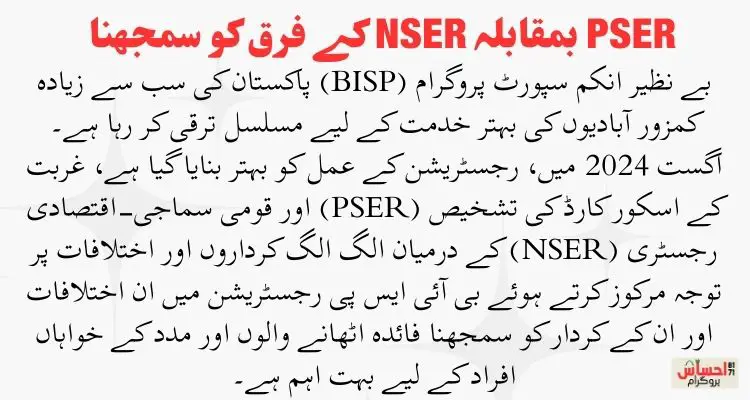The Benazir Income Support Programme (BISP) continues to evolve to better serve Pakistan’s most vulnerable populations. In August 2024, the registration processes have been refined, focusing on the distinct roles and differences between the Poverty Scorecard Evaluation (PSER) and the National Socio-Economic Registry (NSER). Understanding these differences and their roles in BISP registration is crucial for beneficiaries and those seeking assistance.
بے نظیر انکم سپورٹ پروگرام (BISP) پاکستان کی سب سے زیادہ کمزور آبادیوں کی بہتر خدمت کے لیے مسلسل ترقی کر رہا ہے۔ اگست 2024 میں، رجسٹریشن کے عمل کو بہتر بنایا گیا ہے، غربت کے اسکور کارڈ کی تشخیص (PSER) اور قومی سماجی-اقتصادی رجسٹری (NSER) کے درمیان الگ الگ کرداروں اور اختلافات پر توجہ مرکوز کرتے ہوئے بی آئی ایس پی رجسٹریشن میں ان اختلافات اور ان کے کردار کو سمجھنا فائدہ اٹھانے والوں اور مدد کے خواہاں افراد کے لیے بہت اہم ہے۔
Contents
The Role of PSER and NSER in BISP Registration 2024
In 2024, both PSER and NSER play pivotal roles in the BISP registration process, though they serve different functions:
PSER:
- Targeted Poverty Assessment: PSER is employed to identify households living below the poverty line. It plays a critical role in ensuring that BISP aid is directed toward the neediest segments of the population.
- Initial Screening: PSER often serves as the initial screening tool for BISP eligibility, helping to narrow down the pool of potential beneficiaries.
NSER:
- Comprehensive Data Source: NSER acts as a centralized database containing detailed socio-economic information on households. This registry supports a wide range of social protection programs, including BISP.
- Eligibility Confirmation: NSER is used to verify and confirm eligibility for BISP, ensuring that the data aligns with the broader socio-economic context of each household.
Together, PSER and NSER form a robust system that enhances the accuracy and efficiency of BISP registration in 2024, ensuring that assistance reaches those who genuinely need it.

Differences Between PSER and NSER
Understanding the differences between PSER and NSER is essential for grasping how the BISP registration process works:
- Scope:
- PSER: Primarily focused on poverty evaluation, targeting households below a certain poverty threshold.
- NSER: Covers a wider range of socio-economic indicators, offering a more comprehensive view of household conditions.
- Purpose:
- PSER: Used specifically for poverty assessment to determine eligibility for poverty-targeted programs like BISP.
- NSER: Acts as a broad-based registry that supports multiple social protection programs by providing detailed socio-economic data.
- Data Collection:
- PSER: Data is collected periodically, often through field surveys conducted by government representatives.
- NSER: Data is updated regularly and maintained in a centralized database, offering real-time insights into household conditions.
- Eligibility Determination:
- PSER: Eligibility is determined based on a poverty score derived from the evaluation.
- NSER: Eligibility is determined using a broader set of socio-economic criteria, ensuring a more nuanced assessment.
- Role in BISP Registration:
- PSER: Acts as an initial screening tool, identifying potential beneficiaries based on poverty levels.
- NSER: Provides a final confirmation of eligibility, ensuring that those selected meet all the required socio-economic criteria.
FAQs
What is the main difference between PSER and NSER?
PSER focuses on poverty assessment, while NSER is a comprehensive registry covering a wide range of socio-economic factors.
How is the data for PSER collected?
Data for PSER is collected through surveys conducted by government officials or authorized representatives.
Can I be eligible for BISP through both PSER and NSER?
Yes, eligibility for BISP can be determined through both PSER and NSER, depending on the criteria set by the government.
What role does NSER play in BISP registration?
NSER provides a comprehensive database that verifies and confirms eligibility for BISP, ensuring that beneficiaries meet all required socio-economic criteria.
How often is the NSER database updated?
The NSER database is updated regularly to ensure accurate and up-to-date information on households.
Conclusion
In the context of BISP registration in August 2024, both PSER and NSER play crucial roles in identifying and supporting eligible households. While PSER focuses on poverty assessment, NSER offers a broader socio-economic perspective, allowing for more targeted and effective aid distribution. Understanding the differences between these two systems is essential for beneficiaries and those involved in social protection programs.


2 thoughts on “August 2024 BISP Registration: Understanding PSER vs NSER Differences”